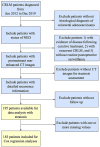Hepatic Steatosis Predicts Higher Incidence of Recurrence in Colorectal Cancer Liver Metastasis Patients
- PMID: 33767997
- PMCID: PMC7986714
- DOI: 10.3389/fonc.2021.631943
Hepatic Steatosis Predicts Higher Incidence of Recurrence in Colorectal Cancer Liver Metastasis Patients
Erratum in
-
Corrigendum: Hepatic Steatosis Predicts Higher Incidence of Recurrence in Colorectal Cancer Liver Metastasis Patients.Front Oncol. 2021 Aug 18;11:742987. doi: 10.3389/fonc.2021.742987. eCollection 2021. Front Oncol. 2021. PMID: 34490128 Free PMC article.
Abstract
Purpose: Colorectal liver metastasis (CRLM) is the major cause of death due to colorectal cancer. Although great efforts have been made in treatment of CRLM, about 60-70% of patients will develop hepatic recurrence. Hepatic steatosis was reported to provide fertile soil for metastasis. However, whether hepatic steatosis predicts higher incidence of CRLM recurrence is not clear. Therefore, we aimed to determine the role of hepatic steatosis in CRLM recurrence in the present study. Methods: Consecutive CRLM patients undergoing curative treatment were retrospectively enrolled and CT liver-spleen attenuation ratio was used to detect the presence of hepatic steatosis. In patients with hepatic steatosis, we also detected the presence of fibrosis. Besides, a systematic literature search was performed to do meta-analysis to further analyze the association between hepatic steatosis and CRLM recurrence. Results: A total of 195 eligible patients were included in our center. Patients with hepatic steatosis had a significantly worse overall (P = 0.0049) and hepatic recurrence-free survival (RFS) (P = 0.0012). Univariate and multivariate analysis confirmed its essential role in prediction of RFS. Besides, hepatic fibrosis is associated with worse overall RFS (P = 0.039) and hepatic RFS (P = 0.048). In meta-analysis, we included other four studies, with a total of 1,370 patients in the case group, and 3,735 patients in the control group. The odds ratio was 1.98 (95% CI: 1.25-3.14, P = 0.004), indicating that patients with steatosis had a significantly higher incidence of CRLM recurrence. Conclusion: In summary, patients with hepatic steatosis had a significantly worse overall and hepatic RFS and it's associated with higher incidence of CRLM recurrence.
Keywords: L/S ratio; colorectal cancer; hepatic recurrence; hepatic steatosis; liver metastasis.
Copyright © 2021 Chen, Dai, Fang, Chen, Jiang, Wei and Ding.
Conflict of interest statement
The authors declare that the research was conducted in the absence of any commercial or financial relationships that could be construed as a potential conflict of interest.
Figures





Similar articles
-
An evaluation model of hepatic steatosis based on CT value and serum uric acid/HDL cholesterol ratio can predict intrahepatic recurrence of colorectal cancer liver metastasis.Int J Clin Oncol. 2024 Sep;29(9):1263-1273. doi: 10.1007/s10147-024-02550-y. Epub 2024 Jun 5. Int J Clin Oncol. 2024. PMID: 38839664
-
Hepatic steatosis predicts metachronous liver metastasis in colorectal cancer patients: a nested case-control study and systematic review.Am J Cancer Res. 2024 Mar 15;14(3):1292-1305. doi: 10.62347/JHMS4303. eCollection 2024. Am J Cancer Res. 2024. PMID: 38590410 Free PMC article.
-
The impact of hepatic steatosis on outcomes of colorectal cancer patients with liver metastases: A systematic review and meta-analysis.Front Med (Lausanne). 2022 Sep 8;9:938718. doi: 10.3389/fmed.2022.938718. eCollection 2022. Front Med (Lausanne). 2022. PMID: 36160137 Free PMC article.
-
D-dimer predicts postoperative recurrence and prognosis in patients with liver metastasis of colorectal cancer.Int J Clin Oncol. 2018 Aug;23(4):689-697. doi: 10.1007/s10147-018-1271-x. Epub 2018 Mar 24. Int J Clin Oncol. 2018. PMID: 29574651
-
Basic research supported developments of chemotherapy in nonresectable isolated colorectal liver metastases to a protocol of hepatic artery infusion using mitoxantrone, 5-FU + folinic acid and mitomycin C.Gan To Kagaku Ryoho. 1999 Feb;26(3):269-81. Gan To Kagaku Ryoho. 1999. PMID: 10065089 Review.
Cited by
-
Combined impact of myosteatosis and liver steatosis on prognosis in stage I-III colorectal cancer patients.J Cachexia Sarcopenia Muscle. 2023 Dec;14(6):2908-2915. doi: 10.1002/jcsm.13369. Epub 2023 Nov 15. J Cachexia Sarcopenia Muscle. 2023. PMID: 37964719 Free PMC article.
-
The Good, the Bad and the New about Uric Acid in Cancer.Cancers (Basel). 2022 Oct 10;14(19):4959. doi: 10.3390/cancers14194959. Cancers (Basel). 2022. PMID: 36230882 Free PMC article. Review.
-
An evaluation model of hepatic steatosis based on CT value and serum uric acid/HDL cholesterol ratio can predict intrahepatic recurrence of colorectal cancer liver metastasis.Int J Clin Oncol. 2024 Sep;29(9):1263-1273. doi: 10.1007/s10147-024-02550-y. Epub 2024 Jun 5. Int J Clin Oncol. 2024. PMID: 38839664
-
CGX, a standardized herbal syrup, inhibits colon-liver metastasis by regulating the hepatic microenvironments in a splenic injection mouse model.Front Pharmacol. 2022 Aug 29;13:906752. doi: 10.3389/fphar.2022.906752. eCollection 2022. Front Pharmacol. 2022. PMID: 36105183 Free PMC article.
-
Altered lipid metabolism as a predisposing factor for liver metastasis in MASLD.Mol Cells. 2024 Feb;47(2):100010. doi: 10.1016/j.mocell.2024.100010. Epub 2024 Jan 17. Mol Cells. 2024. PMID: 38237744 Free PMC article. Review.
References
LinkOut - more resources
Full Text Sources
Other Literature Sources

